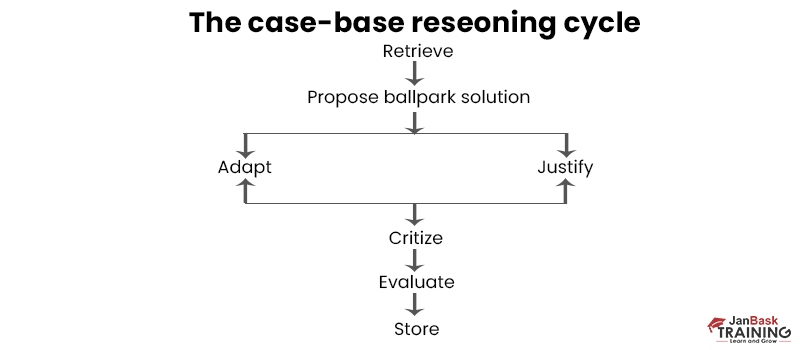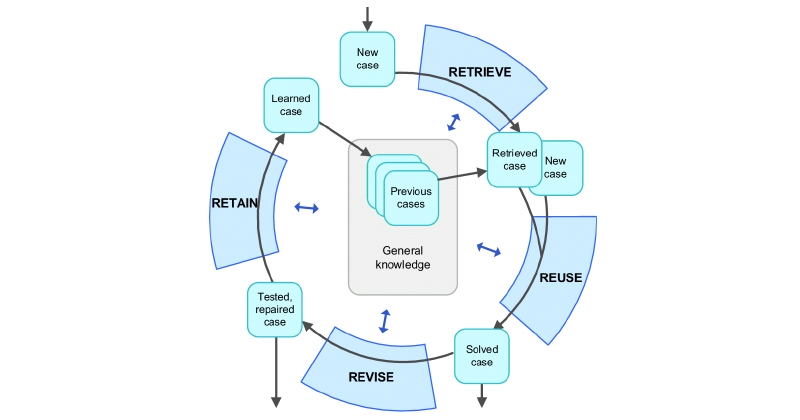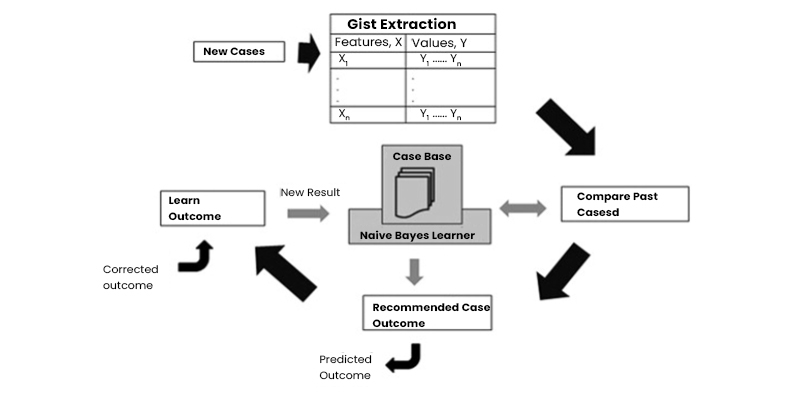Christmas Offer : Get Flat 35% OFF on Live Classes + $999 Worth of Study Material FREE! - SCHEDULE CALL
As the name suggests, case-based reasoning(CBR) is a problem-solving technique based on an artificial intelligence approach, and yet very different from other AI tools. This system usually catalogs past ‘cases’ as an example to find solutions for current problems. Each time a new case is added to the database, the cycle goes on!The interesting factor about case-based reasoning is its ability to retrieve and manipulate the past problems and find the previous best match solution. If unable to do so, it finds the closest match, and once the problem is solved with an imperfect match, it gets added up in the database for future use, much like a physician that learns from his past patients’ experiences. This case-based reasoning algorithm typically scrutinizes patterns, analysis, problem-solving, and planning.
Various other sectors started to adopt CBR as a means of reasoning that might stick out past computational thinking and employ human thinking. Are you enthusiastic about finding out behind the curtains how case-based reasoning actually works, key terms, pros and cons, challenges, and how data science courses can help you and much more?
Case-Based Reasoning, or CBR, is an experiential approach to resolving current problems by acclimatizing formerly right solutions to the same issues. Addressing memory issues, learning, planning, troubleshooting, and case-based reasoning lays the foundation for advanced technology of AI or robotics or intelligent computer systems that could resolve issues and adjust to new circumstances.

In case-based reasoning, the “Clever” reutilization of knowledge from previously solved issues, or cases, depends on the assumption that when there are more than 2 similar issues, there are more analogous solutions for them.
With applications ranging from machine learning to medicine to resolving unclear and unstructured decision-making issues in numerous sectors. Case-based reasoning systems could “learn“ by gaining current knowledge as cases. This, together with the use of database techniques, simplifies the process of managing large amounts of information.Without further ado, let’s explore key terms in CBR
CBR, or Case-based reasoning, is an archetype of AI, including cognitive science, that models a process of reasoning as mainly memory-based.
Let’s have a look at the key terms in CBR-
Normally, case-based reasoning has presumably been known for so long as humans are. Despite the fact that today, we can access numerous cutting-edge tools and technologies, it’s not mandatory to make use of case-based reasoning- just old experiences are required.
Conventionally, the origin of case-based reasoning is connected to the Dynamic Memory Theory of Roger Schank, an American Artificial Intelligence Theorist. He wrote a book in the year 1982 that authorized the case-based reasoning theory, titled - Dynamic Memory: A Theory of Reminding and Learning in Computers and People.He devised a model of memory indicating that humans learn on the basis of preserving experiences and not by retaining logic. Schank said, "Humans aren’t preferably raised to realize stories.” Using his dynamic memory theory, Schank explained how computers and other types of AI comprehend language. In accordance with Schank, algorithms depend on a conceptual understanding of words to grasp their meaning, which he referred to as the Conceptual Dependency Theory.
This is how computers can assign one meaning to two phrases or words rather than encode them as entirely distinct terms. For instance, “give” and “transfer to” are assigned similar meanings by computer devices. By following Schank's dynamic memory and conceptual dependency theories, others started to create models of CBR (case-based reasoning) for machine learning. Every experience is similar to every word and is converted into a more common concept that facilitates similarities to be constructed for future same but unlike experiences. Systems are then developed, where they can learn by gaining new knowledge cases. Janet Kolodner, an American Cognitive and Learning Scientist, then developed the first cased based reasoning system, called “CYRUS - Computerized Yale Retrieval and Updating System.”
Kolodner Then Proposed The Following CBR system -

Kolodner expected the system to indicate both - ML and human information retrieval systems. Like Schank’s theory, Kolodner conceded that we need to move out of the keywords for organizing memory and instead depend on conceptual groups. Her theory was mainly dependent on indexing as well- appropriate indexing is needed for recovering, which is the opening step of the case-based reasoning procedure. U.S. Secretaries of State.
She also differentiated between two types of CBR-
1. Problem-Solving Style, and
2. Interpretive Style.
As an understanding of CBR from the point of view of ML gained traction, other aspects started to adopt it, like a type of reasoning that might expand past computer thinking and relate to human thinking.
The classical Case-Based Reasoning Cycle consists of ML when the user confirms new cases solution.

Case Base:
Case Description:
6-ISE Sensor Array:
H+ , Ca2+, Na+ , K+ , NO3 - , Cl- .
Case Solution:
Recognition of Water recognition (most resembling case, MSC) and concentrations ranging from (mg.1-1) of many ionic species such as HCO3 - , SO4 - , Cl- , Ca2+, Mg2+, Na+, K+
Similitude / Equivalence Function:
Normalized Distance in a 6-dimensional space:

Where ‘fs’ - Is the case similitude/equivalence function, and
d1 & d2 - are the case descriptions array data to compare.
Initial Case Base Data Set:
Following is the full Data-Set for Mineral water samples named W1-W20, and Values of Electronic potential are mentioned in mV: [Image source - rsc.org]

Software:
Custom-built software for actual time acquisition of data and Case-based reasoning processing. It was developed in Java for SUN JRE 1.2 or compatible. This fact facilitates it to execute an app over any platform and OS (Such as Windows, UNIX, Linux, ….., etc.).
Normally, the case-based reasoning process entails
Retrieve- Collecting an experience from memory closest to the existing problem.
Reuse- Recommending a solution depending on the experience and adapting it to fulfill the needs of the current situation.
Revise- Assess the utilization of the result in the new situation.
Retain- Saving this new problem-solving method inside the memory system.
CBR has numerous variations from other artificial intelligence ways like KBS (Knowledge-based Systems). Instead of depending entirely on general knowledge of the scope of analysis or forming associations ahead of the generalized relationship between problem signifier and outcomes, case-based reasoning applies the particular knowledge of previous treatment and actual problem situations.
Case-based reasoning also provides progressive, continuous learning in that every time a problem is resolved, it retains a new experience and could be assigned to future challenges.
Case-based reasoning develops smarter as the number of adjustments in accuracy and efficiency grows as the number of saved cases develops very large. But for a little while, the efficiency of the system will be affected because the time needed to look for and process related cases escalates.
Scientists. bring forward as proof both pros and cons of case-based reasoning. On the positive side, keeping in mind, old experiences help learners prevent repeating earlier mistakes, and the reasoners could anticipate the issue's features and concentrate on them. Additionally, case-based reasoning is spontaneous since it speculates by what method people work. Because lack of knowledge should be called forth to develop rules or various ways, growth is easier.Case-based reasoning also allows the reasoner to come up with solutions to the issues instantly. The reasoner could develop solutions in sectors that he or she doesn’t comprehend, compute solutions when no algorithmic way is available, and clarify open-ended and vague ideas. On the contrary, analyzers assert that the significant area of case-based reasoning depends on evidence from anecdotes. Acclimatizing the elements from one case to another could be complicated and possibly result in incorrect conclusions. Even though the present work has improved CBR with the help of a statistical framework, this could make it feasible to generate case-based predictions with the help of a high degree of confidence.
CBR could help resolve issues more effectively. For instance, if you’re finding it difficult to resolve issues, others will frequently advise you to take it easy and tackle the problem with new perspectives.CBR, particularly, is noticing old problems and their solutions with fresh perspectives and trying to employ them to new problems. It also acknowledges that often, the second time, our approach toward a task is better. We’ve gained some experience, recalled our failures and successes, and made our way accordingly.
Different factors that can impact how efficiently one’s usage of CBR is -
Experience - The more you’re experienced, the more likely you’re to be best at case-based reasoning.
Creativity and Originality - CBR will be effective only if you can think about creative ways to acclimatize old solutions to new issues. Being able to innovate enables you to moderately adjust old techniques and look for new ways to solve problems.
Capability to Understand Situations in The View of Old Experiences - On a fundamental level, CBR needs one to be capable of remembering old experiences, so that a good memory is an important condition for this problem-solving analytical approach. For the CBR model to work successfully, one should identify the difference between new and old problems. Relating links between the two - maybe between resemblances or inconsistencies - will support you in finding out which tactics would be helpful and which won’t be helpful to be applied to the new problem. Listing experiences so that it becomes easy to recall them is crucial.
Potential to Evaluate - Being hard-headed and reasonable pertaining to CBR is essential. You must be capable of competently determining how successful or unsuccessful old achievements were to understand which areas are worth following.
CBR, or Case-based Reasoning, is a prototype of AI, including cognitive science, that develops the reasoning process mostly memory based. Case-based reasoners resolve new issues by regaining stored ‘cases,’ defining the same previous analytical events, and adapting their solutions to fulfill new requirements.

For the last 20 years, several case-based reasoning applications have been created, starting from prototypical apps developed in research laboratories to huge fielded apps built by commercial organizations. Different application areas of case-based reasoning include help-desk and client service, recommender systems used inside electronic commerce, management of knowledge and experience, medical applications, applications while processing an image, applications in law, design, planning, technical analysis, also in computer games, and music sector.
Case-Based Reasoning and Architecture
Just like fashion gets recycled over the years, architects can utilize existing designs to resolve new design issues. Even though the problems that can occur in design are mostly ill-defined or documented, creating it complicated for future architects to find out what went wrong or extrapolate the design to acclimatize it for forthcoming situations. Comparatively, the key reason that very few architectural databases survive is that architects are resistant to Disseminating their designs and gaining knowledge from others with the help of CBR.
Hence, even though the current designs can be helpful tools for new architectural designs, they’re mostly not put into service. Just like indexing, it's crucial for a common memory, indexing is important to be used for previous designs. Fascinated by the shortage of perfectly listed architectural designs, a biomedical researcher named Katharina Ritcher measured a project in Germany that used CBR as an educational tool for architecture students. Previous designs were properly listed and labeled using different criteria to enable students to look for what would be helpful for their existing design project. A table was developed, authorizing participants to strengthen their knowledge from a historical perspective of design and enabling teachers to utilize the table like a reference guide to cast light upon it and offer more examples of their teaching.The teaching project compelled students to utilize an analytical approach to CBR since students were asked to use previous designs for inspiration, which they could pinpoint 2 unique solutions.
Hence the students must scrutinize old solutions and cannot just implement them to current solutions as old architectural designs are overall entities but are also not labeled using information irrespective of whether it was successful or not. It was likely up to the architecture students to estimate whether the architectural design was feasible. Katharina Ritcher identified that architecture students should use an analytical approach for CBR; it taught them to be sensible thinkers. But having said that, it also came up with a lot of issues. Students didn’t always know what they were searching for when they analyzed old designs, and it wasn’t always straightforward for them to identify the design issue, not to mention whether the old solution was helpful or not. Still Katharina Ritcher inferred that a database could be a valuable tool for CBR despite the fact that it was not very successful for CBR.
CBR emulates human reasoning and attempts to resolve new issues by reprocessing solutions deployed for the old same types of issues. It comes with very particular information about the old situations and reprocesses situations, results, and experiences to match the new situational issue. CBR could be utilized for classification as well as regression. It can also be helpful when there are complex cases, like legal cases where the legal cases are complicated legal rulings, and in planning, where the cases are old solutions to complicated issues.
Data Science courses will bring along many benefits with them. You can get certified with “in-demand” big data analytics. Gain practical knowledge of data science concepts from basic to advanced levels, along with R or Python, ML, AI, and deep learning, in detail.Data science online training offered by JanBask Training allows you to master data science concepts depending on real-life industry cases, which helps grow your job market value.
A qualitative way to model case-based reasoning applications utilizes the explanation of AM (Abstract Model) which is consequently aligned with a CM (Concrete Model). The AM indicates the domain to which case based model is assigned, and its explanation requires specifically the knowledge of a professional in the respective application sector.
Currently, this model’s key advantage is that it facilitates task division among domain experts and case-based reasoning. The CBR modeling process has the capability to stimulate the use of CBR in huge no. of sectors where computer science professionals are uncommon.
Contact our data science experts at JanBask Training today if you wish to learn data science online along with case-based reasoning. Do let us know how you find this blog by commenting below.
—-------------------------------------------FAQs—---------------------------------------------------------
What should I expect after the completion of Data Science online training?
Once you complete the Data Science online training course-
What is the Function of Coding in Data Science?
An average degree of coding is essential for Data Science. It needs just enough coding knowledge to transform and analyze data or ML packages for advanced users, which could be further elevated with the right data science training.
What Other Career Options are Present After Doing Data Science Besides Being Doing Data Scientist Training?
Lately, data science careers have been creating quite the buzz, and it’s not baseless. With the help of the best data science certification & affordable data science course fees, the chances are limitless.
Here are the top careers that you can opt for after you complete your data science course:

Basic Statistical Descriptions of Data in Data Mining



What is Model Evaluation and Selection in Data Mining?

Cyber Security

QA

Salesforce

Business Analyst

MS SQL Server

Data Science

DevOps

Hadoop

Python

Artificial Intelligence

Machine Learning

Tableau
Download Syllabus
Get Complete Course Syllabus
Enroll For Demo Class
It will take less than a minute
Tutorials
Interviews
You must be logged in to post a comment